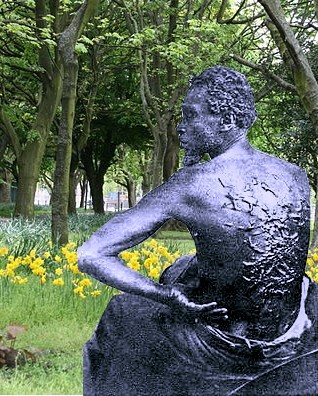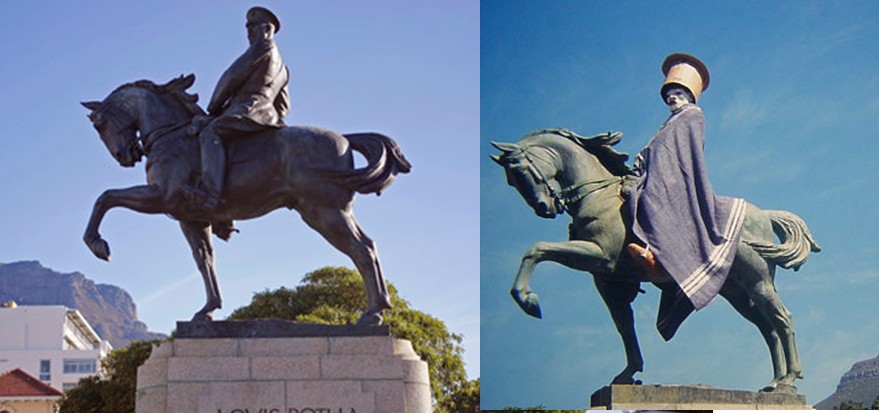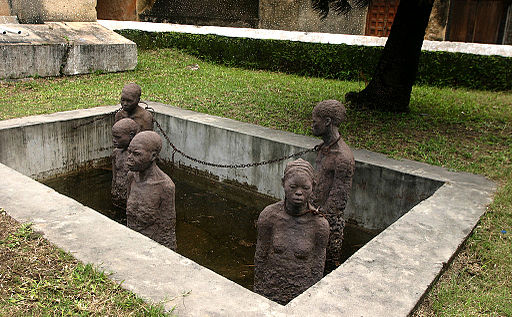aNewDomain – So many aspects of America’s cultural battles can just as easily be argued in the opposite direction with radically different results.
I mean, take Confederate statues.

Pres. Donald Trump and lots of other “tradition”-loving folks are all about honoring Confederate flags and monuments.
This makes me wonder: Do white people really want to remind each succeeding generation of African Americans that their ancestors were once slaves? That’s not a prudent desire, but it’s fittingly arrogant.
And do African Americans really want any and all Antebellum statues removed? Maybe it is good to have a few to keep a slow boil of rage going forever — and delivering some motivation in the face of complacency.
The best idea for everyone in this case might be to give Confederate statues a facelift or create new ones that actually show what it was that Dixie fought so hard for — the right to own other humans as slaves, split up their families, abuse them, impregnate them or anything else you want to do with something you paid good money for.
The new face of Antebellum era statues?
I wonder if the same folks complaining about history being “erased” would be as keen to embrace this type of monument to slavery?
Embracing the magical never-was Gone with Wind Antebellum South must surely be twined with the absolutely-was reality of slavery.
Just as there are millions of descendants of slaves, there are millions of descendants of slave owners and even more folks who benefited from slavery.
In terms of family history, when the Civil War comes up, I prefer to talk about my great-great-grandfather Isaac Adams (1837-1864), who was a sergeant in the 125th Illinois Infantry Regiment and died on a Union hospital train from battle wounds. Sgt. Adams is buried in the Chattanooga National Cemetery.
But then there’s the other side of the family, the slave owning side. It’s simply impossible to justify what they did, and there’s nothing glorious or ennobling about it. There’s simply nothing to celebrate.
One particular great-great grandfather couldn’t afford to purchase a female house slave and her young son, so he just bought the woman and not her son. This transaction occurred in Alabama, and the family soon moved to Texas.
After the war was over and the woman was freed, my great-great grandmother supposedly packed some food for the former slave who then began a walk back to Alabama to reclaim her son. Over the years, a story has been told that the woman reached Alabama, found her son, and they lived happily ever after.
This part of the story sounds completely improbable to me. I’m guessing that’s because it probably was just a fairytale someone thought to tell the horrified little white children listening to our family story.
It’s brutal and awful to think about, truly. But dwelling on ideas like this is just what you need to do to inspire a new kind of Confederate statue.
Instead of a boring statue of a prosperous slave owner astride a healthy steed, how about a statue depicting a mother who watches in horror as her son is sold a way — or searches the rest of her life for him.
Now that’s real heroism, nobility and duty. And that’s art, truly, the ability to have a bit of stone transmit all that.
Certainly the human instincts it would memorialize are a lot more ‘beautiful,’ to use Trump’s word describing the value of Confederacy monuments, than what’s out there right now.
In 1999, South African artist Beezy Bailey transformed a statue of an apartheid era hero Louis Botha into a Xhosa warrior. The irony was magnificent. Of course, Bailey received death threats. His transformation was only temporary, and even the new South African government has kept the statue of Botha up – although it continually receives protests.
Here’s the Botha statue before and after:

So, why not take some of the existing confederate army statues and change them into slave statues. I’m all for transforming Jefferson Davis statues into Frederick Douglas statues – at least for a while?

And if the system was as vile as we know it to be — as the army of soldiers fighting for the Union knew it to be — then why not cast its defenders in another light?
However noble Marse Robert or Bobby Lee might have been, however well-muscled his horse might have been, however snappy his uniform might have been, however tidily his beard might have been clipped, however skillfully he killed American soldiers, however deftly he delayed justice, he was putting in his all to fight a system that wanted to get between him and his right to own another man.
It’s strange enough that any country would allow those who tried to overthrow it — and lost — the freedom to keep posting their symbols, flags and sentiments.
But at least they should man up and admit what it is they’re defending. And make their statues and other historical leftovers from their losing effort to destroy our nation tell the truth about what that system was.
For aNewDomain, I’m Tom Ewing.
Cover image: By Brocken Inaglory (Own work) [CC BY-SA 3.0 or GFDL], via Wikimedia Commons. Slavery statues: Created by Tom Ewing for aNewDomain, from historic photographs of slaves.













